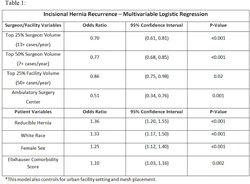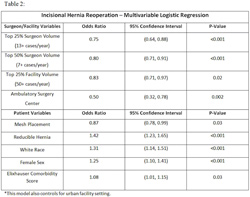|
Back to 2014 Annual Meeting Abstracts
Surgeon and Facility Volume Play Significant Role in Hernia Recurrence and Reoperation After Open Incisional Hernia Repair
Christopher T. Aquina*1, Fergal Fleming1, Kristin N. Kelly1, Christian P. Probst1, Katia Noyes1, Howard N. Langstein2, John R. Monson1
1Surgical Health Outcomes and Research Enterprise (SHORE), University of Rochester Medical Center, Rochester, NY; 2Plastic & Reconstructive Surgery, University of Rochester Medical Center, Rochester, NY
Purpose:
Incisional hernia is a common complication following gastrointestinal surgery occurring in up to 20% of patients. Many surgeons elect to perform their own incisional hernia repairs despite performing only a small number of hernia repairs annually. There is no prior literature on the association between surgeon volume, facility characteristics, and incisional hernia repair outcomes. This study examines the relationship between physician and institutional characteristics, hernia recurrence, and reoperation rates following open initial hernia repair.
Methods:
Patients undergoing open initial incisional hernia repair between 2000 and 2006 were selected by CPT code from the New York Statewide Planning and Research Cooperative System (SPARCS). Incisional hernia recurrence and surgical repairs over a five year period were determined by ICD-9 and CPT codes. Surgeon and facility volumes were calculated as a mean number of initial incisional hernia repairs per year over the 2000 to 2006 period. Additional facility characteristics included academic status, bed number, and urban/rural location. Univariate analysis was used to compare patient, surgeon, and facility characteristics with incisional hernia recurrence and reoperation. Factors with a p-value < 0.1 were included in multivariable logistic regression.
Results:
A total of 18,171 patients underwent open initial incisional hernia repair in New York State in 2000-2006. The mean number of initial hernia repairs per year were 39 for facilities (median = 30, range = 1-138) and 10 for individual surgeons (median = 7, range = 1-64). The hernia reoperation rate was 6.8% with a captured hernia recurrence rate of 8.9%. The mean time between initial hernia repair and reoperation was 24 months (median = 19, range = 0.1-60). After adjusting for patient and facility characteristics, both upper 50th percentile and top 25th quartile for surgeon volume, top 25th quartile for facility volume, and status as an ambulatory surgery center were significantly protective for both hernia recurrence (Table 1) and hernia reoperation (Table 2). Academic status, facility size, and urban/rural location of the institution were not significantly associated with hernia recurrence or reoperation.
Conclusions:
This study suggests a strong association between individual surgeon and facility incisional hernia repair volume and the subsequent risk of incisional hernia recurrence and reoperation. Referral to high-volume surgeons and institutions may lead to improved patient outcomes and lower costs.


Back to 2014 Annual Meeting Abstracts
|



